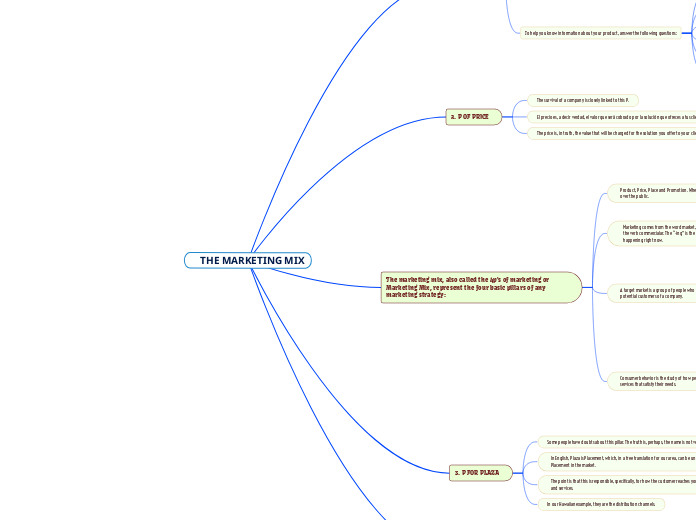THE MARKETING MIX
1P. OF PRODUCT
A company needs to offer something.
The Product here must also encompass services offered by a business.
The Product is used so that your team
understand and define
What attributes and characteristics does what is being offered have.
.To help you know information about your product, answer the following questions:
What are the needs and/or desires that your product/service must satisfy of your customers?
What are the functions you must develop to get them what they need?
How, when and where will the client use it?
What is he like physically?
What name does it have?
How is it different from other products and services already on the market?
2. P OF PRICE
The survival of a company is closely linked to this P.
El precio es, a decir verdad, el valor que será cobrado por la solución que ofreces a tus clientes.
The price is, in truth, the value that will be charged for the solution you offer to your clients.
The marketing mix, also called the 4p's of marketing or Marketing Mix, represent the four basic pillars of any marketing strategy:
Product, Price, Place and Promotion. When all 4 are in balance, they tend to influence and win over the public.
Some processes to keep in mind:
• Is the logistics of your main distribution channel profitable?
• What are your scheduling and delivery logistics like?
• Will your third-party retailers run out of product at critical times?
• Do you have enough staff to cover the busiest times?
• Are items shipped reliably from your website?
Marketing comes from the word market, which can be translated as market, or “to market”, from the verb commercialar. The “-ing” is the suffix that can be used to present an action that is happening right now.
So, if we take this construction as a hook for the formation of the word, we have “the action of marketing now” as marketing.
A target market is a group of people who share common characteristics and who can be potential customers of a company.
Some characteristics of a target market are
• Compatibility with the image and objectives of the company
• Profitability, that is, a high number of sales with a low investment
• Breadth and scope, that is, a sufficient number of potential clients
• Growth, i.e. an increase in demand and market opportunities
• Little competition, that is, a differential advantage over other bidders
Consumer behavior is the study of how people choose, purchase, use, and evaluate products or services that satisfy their needs.
There are four types of consumer behavior depending on the level of involvement and the difference between brands
• Complex: The consumer does a lot of research before purchasing an expensive or luxury product or service.
• Comparative: the consumer compares between several options for similar products or services.
• Habitual: the consumer buys out of habit or loyalty to a brand without seeking much information.
• Impulsive: the consumer buys out of emotion or desire without thinking much about the consequences.
3. P FOR PLAZA
Some people have doubts about this pillar. The truth is, perhaps, the name is not very clear.
In English, Plaza is Placement, which, in a free translation for our area, can be understood as Placement in the market.
The point is that this is responsible, specifically, for how the customer reaches you, your products and services.
In our Hawaiian example, they are the distribution channels.
4. P for PROMOTION
Promotion, here, is different from the idea of clearance and offers that we see in so many shopping centers.
Actually, promotion has the meaning of promoting your brand and solutions, making your brand's marketing message reach the right ears.
Transform your company, from a mere unknown, into a possible solution to a client's needs and desires.
